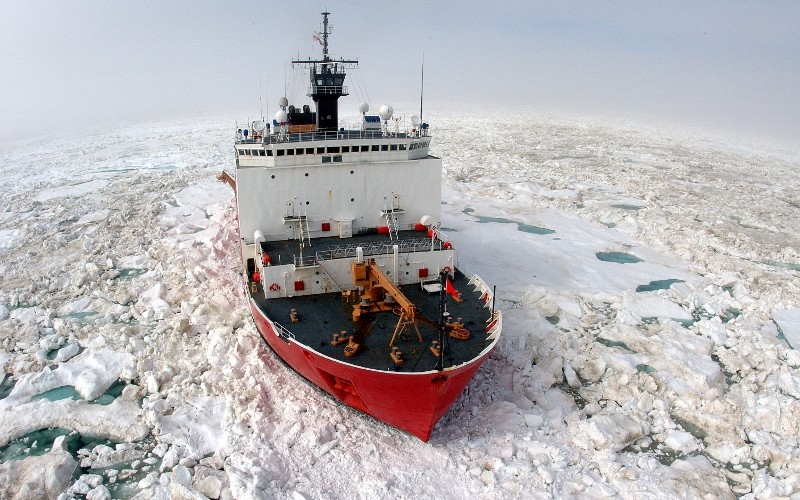Mounting mission demands in the Arctic region, with climate change, increased shipping traffic and geopolitical challenges are taxing the Coast Guard’s role in the far north.
A new report from the Government Accountability Office recognizes those mounting demands on the Coast Guard. But the GAO study found incomplete reporting of how the Coast Guard used its ships, aircraft and other assets, and mission performance from 2016 through 2021.
In some reporting years the Coast Guard did not include targets for critical missions, like maritime law enforcement.
“Reports were also unavailable for fiscal years 2022 and 2023,” according to a GAO summary. “Collecting and reporting complete information would better position the Coast Guard to make more informed operational planning decisions for the region.”
“The Coast Guard hasn't fully tracked the time spent on its Arctic activities,” according to the GAO, which is the non-partisan auditing and accounting arm of Congress. “Complete information would help the Coast Guard better allocate its constrained resources and assess its progress toward achieving its Arctic strategic goals.”
The GAO conducted its audit from January 2023 through August 2024. Its auditing staff reviewed how the Coast Guard does its operational planning and global force management and develops performance reports.
“We also interviewed Coast Guard officials about how they assess, manage, and mitigate risks to Coast Guard operations and infrastructure, commercial maritime operations, and the maritime environment in the Arctic region,” auditors wrote in their report. “We conducted a site visit to Juneau, Alaska, to interview officials from Coast Guard District 17 and the Marine Exchange of Alaska.”
The auditors also reviewed how the Coast Guard works with other branches of the U.S. military in the Arctic region. Their conclusions make two major recommendations to the Coast Guard:
“The Commandant of the Coast Guard should ensure that District 17 collects and reports complete information about resource use and mission performance in accordance with Coast Guard guidance.”
“The Commandant of the Coast Guard should ensure that the Coast Guard’s Arctic implementation plan includes performance measures with associated targets and time frames for the action items described in the plan in accordance with Coast Guard guidance.”
The Coast Guard plans to acquire 28 new cutters, including a new class of three Polar Security Cutters that will replace the Coast Guard’s remaining two operational high seas icebreakers. “However, in the interim, the Coast Guard has projected it will have a reduced number of ships available for operations through FY 2039,” the GAO auditors note. “Until these new ships enter service, cutter and icebreaker shortages may continue to challenge the Coast Guard’s ability to meet its strategic commitments in the U.S. Arctic region and other regions.”
In the meantime, the Coast Guard is using a $125 million appropriation, obtained by Alaska’s Congressional delegation, to acquire the 360’8”x80’x34’ Aiviq, an anchor handling tug originally built for Royal Dutch Shell’s plans for Arctic drilling, to be converted into an interim icebreaker.
The age of its iceabreakers is just part of the Coast Guard’s material challenges in the Arctic. The 399’ heavy icebreaker Polar Star is approaching 50 years old, and the 420’ Healy medium icebreaker was launched in 1997.The GAO report describes how the Coast Guard’s “operational challenges in the U.S. Arctic region are amplified by limited infrastructure and logistics capabilities in Alaska.”
“In addition to major cutters and icebreakers, the Coast Guard also forward deploys helicopters to the U.S. Arctic region as part of Operation Arctic Shield. The Coast Guard operates these helicopters from a leased Alaska National Guard aircraft hangar in Kotzebue, Alaska, because it lacks such infrastructure in the Arctic region.
“Coast Guard officials also told us that it can take weeks to transport large spare parts, such as helicopter rotor blades, to their destinations in the region because they must be shipped by barge over long distances. These logistical challenges can further limit Coast Guard assets’ availability to conduct missions.”
The auditors found Coast Guard District 17 operational performance reports from federal fiscal year 2016 through FY 2021 were partially complete or incomplete.
Coast Guard officials explained how data losses and personnel limitations contributed to the incomplete records, auditors reported.
“Coast Guard guidance requires field units to complete these reports, which are used as part of its annual planning process,” the report states. “This process is the Coast Guard’s primary mechanism for allocating resources and providing strategic direction to operational commanders.”
“Ensuring that District 17 collects and reports complete information would enable the Coast Guard to better monitor its resource use and mission performance in the U.S. Arctic,” the auditors wrote. “This, in turn, would enable better operational planning decisions and more accurate assessments of the Coast Guard’s future resource needs to meet its strategic commitments.”



.jpg.small.400x400.jpg)

